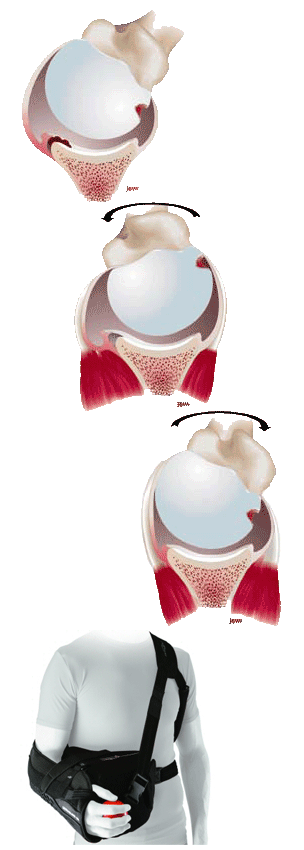
Introduction
The Ultrasling® PRO is for use after initial anterior shoulder dislocation or post operatively when external rotation is desired. The anterior part of the capsule hangs loosely during internal rotation and the labrum is able to displace medially. It is now known that in external rotation, the subscapularis tendon tightens thus closing the anterior joint cavity and helping the labrum maintain a good position on the glenoid rim. Translated this evidence base means better healing of the fibrocartilagenous lip that tears off the rim of the socket when the shoulder dislocates.
Indications
• Anterior dislocations
• Initial anterior glenohumeral dislocation/subluxation
• Capsular shifts
• Use after posterior shoulder repair
• Postoperative Bankart procedures
• Soft tissue strains/repairs
• Post operative positioning after release of severe anterior capsule contracture
• Adhesive Capsulitis release/manipulation
Information on Ordering
Choose PRO,PRO AB or PRO ER15 or ER30 Degrees.
Innovations
• Abduction, 15° and 30° versions to suit your protocol
• Comfortable foam pillow for patient compliance
• Derotational shoulder strap to keep product in place
• Quick release buckles make it easy to take on and off
• Popular UltraSling materials and adjustable straps for patient comfort
• Universal sizes to suit your patients needs
Shoulder Bracing after First Dislocation
OrthopaedicsAndTrauma.com asked shoulder surgeon Mark Crowther to comment on the use of these innovative slings following shoulder dislocation. Mark is a Consultant Shoulder Surgeon in Bristol in the UK.
Mark told OrthopaedicsandTrauma.com "There is more than one paper from the Akita University School of Medicine, Japan that shows the traditional method of immobilisation of the shoulder under the cloths in internal rotation after dislocation might not be the best especially for young patients who dislocate following trauma". Itoi E, Sashi R, Minagawa H, Shimizu T, Wakabayashi I, Sato K. Position of immobilization after dislocation of the glenohumeral joint. A study with use of magnetic resonance imaging. J Bone Joint Surg Am. 2001;83-A(5):661-7.
The latest evidence based study shows no difference between immobilisation in external rotation for 3 weeks compared for 5 weeks. Three weeks has been the traditional time for immobilisation of a shoulder after dislocation. Scheibel M, Kuke A, Nikulka C, Magosch P, Ziesler O, Schroeder RJ. How Long Should Acute Anterior Dislocations of the Shoulder Be Immobilized in External Rotation? Am J Sports Med. 2009 Mar 23. [Epub ahead of print]. Mark said that he decided on whether a patient needed the 30 or 15 degrees of external rotation clinically by seeing how far into external rotation in neutral a patient could tolerate after dislocation.